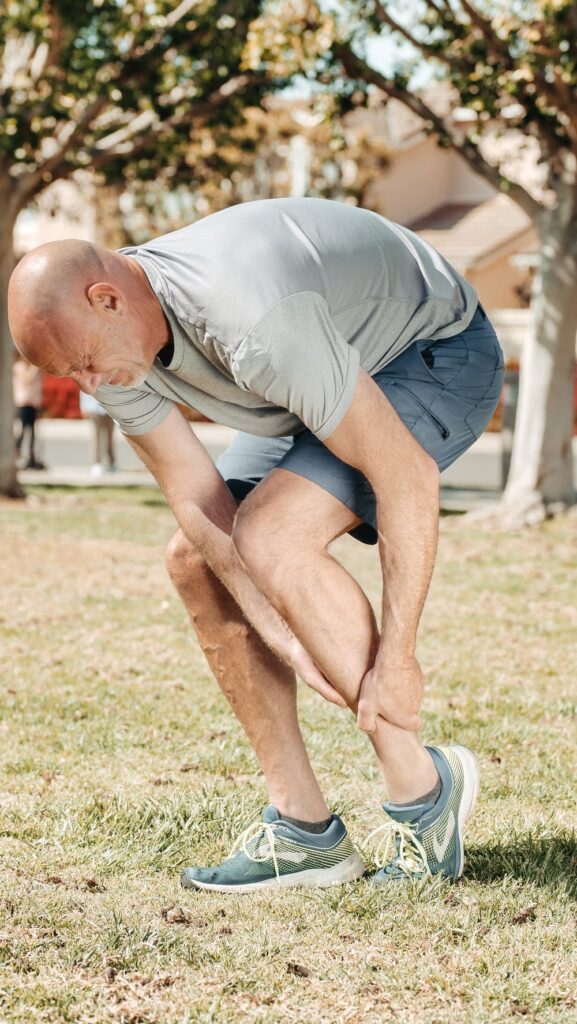Prevent Achilles tendinopathy while training for your marathon
What is Achilles tendinopathy?
The Achilles tendon is the strongest and largest tendon in the human body, connecting the muscles in the calf to the heel bone. This allows for powerful propulsion during activities such as running and jumping. However, excessive or sudden increases in physical activity can lead to a condition known as Achilles tendinopathy, characterized by pain, inflammation, and changes in the structure of the tendon fibers.
Normally, the fibers of the Achilles tendon are organized in a straight line, aligning with the forces placed on the tendon. However, in cases of Achilles tendinopathy, the fibers lose their proper structure and there is an increase in cells within the tendon. This results in pain and swelling, which can worsen with continued physical activity.
It’s often assumed that Achilles tendinopathy is caused by inflammation, however, recent studies have shown that there is a limited role of inflammatory cells in athletes with the condition. This is in contrast to tendinitis, which is an inflammatory condition.
Proper rest and recovery, as well as gradual increases in physical activity and targeted exercises to strengthen the calf muscles, can help prevent Achilles tendinopathy. In case of injury, early diagnosis and treatment by a sports therapist or physical therapist can improve recovery and prevent the injury from becoming chronic.
Symptoms of Achilles tendinopathy include:
- Gradual onset of Achilles tendon pain.
- Local swelling and pain of the Achilles tendon.
- The Achilles tendon pain is related to (sports) load.
- Localized morning stiffness.
How often does it occur?
About 8% of recreational runners suffer from this injury and more than half of top runners suffer an Achilles tendon injury at some point in their running career.
How to prevent it?
There is no hard evidence on how to prevent Achilles tendinopathy, but there are some steps you can take which may have a preventive effect.
- Gradually increase your mileage: One of the most common causes of Achilles tendinopathy is suddenly increasing the amount of running you do without giving your body time to adapt. To prevent this, make sure to gradually increase your mileage over time, and give your body time to adjust to the new demands you’re placing on it.
- Strengthen your calf muscles: Strong calf muscles may help take some of the stress off of your Achilles tendon. Incorporate calf-strengthening exercises such as calf raises and heel drops into your training routine.
- Wear proper shoes: Make sure your running shoes are in good condition and offer adequate support for your feet and ankles. Consider consulting a running store for shoe fitting and ensure that your shoes are appropriate for the type of running you are doing. Running shoes lose their cushioning and support over time, so it’s essential to replace them regularly.
- Cross-train: Incorporate other forms of exercise into your training, such as cycling or swimming. This may help reduce the stress on your Achilles tendon and provide a good overall workout. Variety in your training also helps to reduce the risk of other overuse injuries.
- Rest and recovery: Make sure to give your body adequate time to rest and recover between runs. Listen to your body and if you feel any pain or discomfort, take a break and allow the affected area to heal.
- Consider consultation with a sports therapist or physical therapist if you have a history of Achilles tendinopathy or any other running-related injuries. They can help you to identify any underlying issues and provide a personalized rehabilitation program.
WHAT’S THE NEXT STEP?
We are ready to help you create a personal training program, monitor your stress and recovering activity and advise you on a well-structured plan when gradually increase your mileage while training for a marathon.
Remember, prevention is key, and it’s always better to take preventative measures than to treat an injury once it has occurred. Don’t push through pain and give your body the time it needs to heal, so you can reach the finish line. Let´s do this together!

